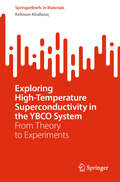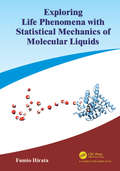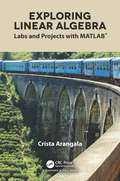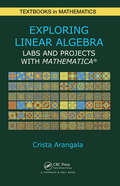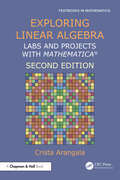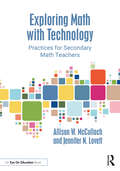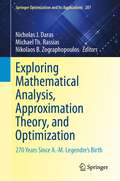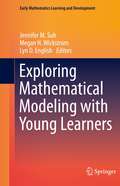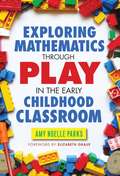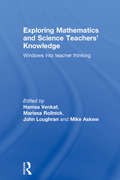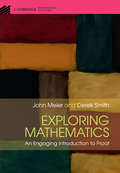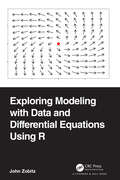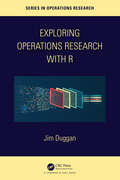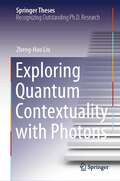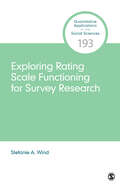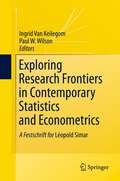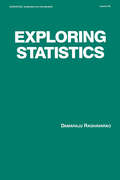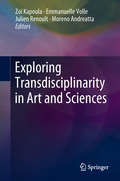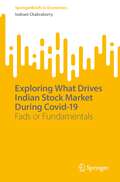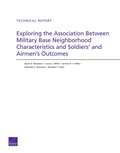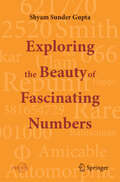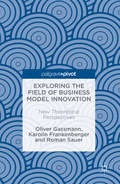- Table View
- List View
Exploring High-Temperature Superconductivity in the YBCO System: From Theory to Experiments (SpringerBriefs in Materials)
by Keltoum KhallouqThe book explores the properties and behaviors of high-critical-temperature superconductors in the yttrium barium copper oxide (YBCO) system, looking specifically at Y0.5Ln0.5BaSrCu3O6+z compounds, where Ln represents rare earth elements like europium (Eu), samarium (Sm), and (neodymium) Nd. Structured into several chapters, it navigates through key aspects of superconductivity and its characterization. Starting with an introduction to the discovery of high-critical-temperature superconductors and their far-reaching applications, it sheds light on unresolved questions in materials physics, particularly concerning the behavior of the copper(II)-oxide (CuO2) planes and the introduction of additional electronic holes. Emphasizing the pivotal role of the CuO2 planes in shaping material properties above the critical temperature, it also delves into the history of superconductivity, properties of superconducting materials, and various types of superconductors. Phenomenological theories like the London theory, Ginzburg-Landau theory, and Abrikosov's theory of the mixed state in type II superconductors are discussed, along with conventional theories such as the BCS theory and Josephson junctions. The book provides an overview of experimental techniques used to characterize structural, magnetic, and electrical properties of superconductor compounds, including X-ray diffraction, scanning electron microscopy, and magnetometry. Focusing on the structural, magnetic, and electrical properties of Y0.5Ln0.5BaSrCu3O6+z compounds, along with the effects of substitutions and thermal treatments, the book aims to achieve several objectives. These include a comparative study of superconducting and structural properties under various thermal treatments and isovalent substitutions, analysis of magnetic susceptibility and electrical resistivity as functions of temperature, investigation of the evolution of mixed-state properties with changing temperatures, and utilization of the Rietveld crystallographic refinement method to establish correlations between interatomic distances and critical temperatures. Additionally, the book presents the synthesis of studied compounds through solid-state reactions and subsequent thermal treatments, including annealing under oxygen and argon atmospheres. The results of these treatments are discussed in relation to improvements in irreversibility lines, magnetic shielding, and grain quality.
Exploring Life Phenomena with Statistical Mechanics of Molecular Liquids: Exploring Life Phenomena
by Fumio HirataIn a living body, a variety of molecules are working in a concerted manner to maintain its life, and to carry forward the genetic information from generation to generation. A key word to understand such processes is "water," which plays an essential role in life phenomena. This book sheds light on life phenomena, which are woven by biomolecules as warp and water as weft, by means of statistical mechanics of molecular liquids, the RISM and 3D-RISM theories, both in equilibrium and non-equilibrium. A considerable number of pages are devoted to basics of mathematics and physics, so that students who have not majored in physics may be able to study the book by themselves. The book will also be helpful to those scientists seeking better tools for the computer-aided-drug-discovery. Explains basics of the statistical mechanics of molecular liquids, or RISM and 3D-RISM theories, and its application to water. Provides outline of the generalized Langevin theory and the linear response theory, and its application to dynamics of water. Applies the theories to functions of biomolecular systems. Applies the theories to the computer aided drug design. Provides a perspective for future development of the method.
Exploring Linear Algebra: Labs and Projects with MATLAB® (Textbooks in Mathematics #18)
by Crista ArangalaThis text is meant to be a hands-on lab manual that can be used in class everyday to guide the exploration of the theory and applications of linear algebra. For the most part, labs can be used individually or in a sequence. Each lab consists of and explanation of material with integrated exercises. Some labs are split into multiple subsections and thus exercises are separated by those subsections.The exercise sections integrate problems using Mathematica demonstrations (an online tool that can be used with an browser with java capabilities) and Matlab coding. This allows students to discover the theory and applications of linear algebra in a meaningful and memorable way
Exploring Linear Algebra: Labs and Projects with Mathematica (Textbooks in Mathematics)
by Crista ArangalaExploring Linear Algebra: Labs and Projects with Mathematica is a hands-on lab manual for daily use in the classroom. Each lab includes exercises, theorems, and problems that guide your students on an exploration of linear algebra. The exercises section integrates problems, technology, Mathematica visualization, and Mathematica CDFs, enabling stude
Exploring Linear Algebra: Labs and Projects with Mathematica ® (Textbooks in Mathematics)
by Crista ArangalaThis text focuses on the primary topics in a first course in Linear Algebra. The author includes additional advanced topics related to data analysis, singular value decomposition, and connections to differential equations. This is a lab text that would lead a class through Linear Algebra using Mathematica® demonstrations and Mathematica® coding.The book includes interesting examples embedded in the projects. Examples include the discussions of “Lights Out”, Nim, the Hill Cipher, and a variety of relevant data science projects.The 2nd Edition contains: Additional Theorems and Problems for students to prove/disprove (these act as theory exercises at the end of most sections of the text) Additional sections that support Data Analytics techniques, such as Kronecker sums and products, and LU decomposition of the Vandermonde matrix Updated and expanded end-of-chapter projects Instructors and students alike have enjoyed this popular book, as it offers the opportunity to add Mathematica® to the Linear Algebra course.I would definitely use the book (specifically the projects at the end of each section) to motivate undergraduate research.—Nick Luke, North Carolina A&T State University.
Exploring Math with Technology: Practices for Secondary Math Teachers
by Allison W. McCulloch Jennifer N. LovettThis timely book provides support for secondary mathematics teachers learning how to enact high-quality, equitable math instruction with dynamic, mathematics-specific technologies. Using practical advice from their own work as well as from interviews with 23 exceptional technology-using math teachers, the authors develop a vision of teaching with technology that positions all students as powerful doers of mathematics using math-specific technologies (e.g., dynamic graphing and geometry applications, data exploration tools, computer algebra systems, virtual manipulatives). Each chapter includes sample tasks, advice from technology-using math teachers, and guiding questions to help teachers with implementation. The book offers a rich space for secondary math teachers to explore important pedagogical practices related to teaching with technology, combined with broader discussions of changing the narratives about students – emphasizing the mathematics they can do and the mathematics they deserve. Accompanying online support materials include video vignettes of teachers and students interacting around technology-enhanced tasks in the classroom, as well as examples of more than 30 high-quality technology-enhanced tasks.
Exploring Mathematical Analysis, Approximation Theory, and Optimization: 270 Years Since A.-M. Legendre’s Birth (Springer Optimization and Its Applications #207)
by Nicholas J. Daras Michael Th. Rassias Nikolaos B. ZographopoulosThis book compiles research and surveys devoted to the areas of mathematical analysis, approximation theory, and optimization. Being dedicated to A.-M. Legendre's work, contributions to this volume are devoted to those branches of mathematics and its applications that have been influenced, directly or indirectly, by the mathematician. Additional contributions provide a historical background as it relates to Legendre's work and its association to the foundation of Greece's higher education.Topics covered in this book include the investigation of the Jensen-Steffensen inequality, Ostrowski and trapezoid type inequalities, a Hilbert-Type Inequality, Hardy’s inequality, dynamic unilateral contact problems, square-free values of a category of integers, a maximum principle for general nonlinear operators, the application of Ergodic Theory to an alternating series expansion for real numbers, bounds for similarity condition numbers of unbounded operators, finite element methods with higher order polynomials, generating functions for the Fubini type polynomials, local asymptotics for orthonormal polynomials, trends in geometric function theory, quasi variational inclusions, Kleene fixed point theorems, ergodic states, spontaneous symmetry breaking and quasi-averages.It is hoped that this book will be of interest to a wide spectrum of readers from several areas of pure and applied sciences, and will be useful to undergraduate students, graduate level students, and researchers who want to be kept up to date on the results and theories in the subjects covered in this volume.
Exploring Mathematical Modeling with Young Learners (Early Mathematics Learning and Development)
by Lyn D. English Jennifer M. Suh Megan H. WickstromThis book conceptualizes the nature of mathematical modeling in the early grades from both teaching and learning perspectives. Mathematical modeling provides a unique opportunity to engage elementary students in the creative process of mathematizing their world.A diverse community of internationally known researchers and practitioners share studies that advance the field with respect to the following themes: The Nature of Mathematical Modeling in the Early GradesContent Knowledge and Pedagogy for Mathematical ModelingStudent Experiences as ModelersTeacher Education and Professional Development in ModelingExperts in the field provide commentaries that extend and connect ideas presented across chapters. This book is an invaluable resource in illustrating what all young children can achieve with mathematical modeling and how we can support teachers and families in this important work.
Exploring Mathematics
by L. Carey BolsterBasic math concepts using basic facts, multiplication concepts/facts and division concepts/facts
Exploring Mathematics Through Play in the Early Childhood Classroom (Early Childhood Education series)
by Amy Noelle ParksThis practical book provides pre- and inservice teachers with an understanding of how math can be learned through play. The author helps teachers to recognize the mathematical learning that occurs during play, to develop strategies for mathematizing that play, and to design formal lessons that make connections between mathematics and play. Common Core State Standards are addressed throughout the text to demonstrate the ways in which play is critical to standards-based mathematics teaching, and to help teachers become more familiar with these standards. Classroom examples illustrate that, unlike most formal tasks, play offers children opportunities to solve nonroutine problems and to demonstrate a variety of mathematical ways of thinking--such as perseverance and attention to precision. This book will help put play back into the early childhood classroom where it belongs.
Exploring Mathematics and Science Teachers' Knowledge: Windows into teacher thinking
by Mike Askew Marissa Rollnick John Loughran Hamsa VenkatGlobally, mathematics and science education faces three crucial challenges: an increasing need for mathematics and science graduates; a declining enrolment of school graduates into university studies in these disciplines; and the varying quality of school teaching in these areas. Alongside these challenges, internationally more and more non-specialists are teaching mathematics and science at both primary and secondary levels, and research evidence has revealed how gaps and limitations in teachers’ content understandings can lead to classroom practices that present barriers to students’ learning. This book addresses these issues by investigating how teachers’ content knowledge interacts with their pedagogies across diverse contexts and perspectives. This knowledge-practice nexus is examined across mathematics and science teaching, traversing schooling phases and countries, with an emphasis on contexts of disadvantage. These features push the boundaries of research into teachers’ content knowledge. The book’s combination of mathematics and science enriches each discipline for the reader, and contributes to our understandings of student attainment by examining the nature of specialised content knowledge needed for competent teaching within and across the two domains. Exploring Mathematics and Science Teachers’ Knowledge will be key reading for researchers, doctoral students and postgraduates with a focus on Mathematics, Science and teacher knowledge research.
Exploring Mathematics: An Engaging Introduction to Proof (Cambridge Mathematical Textbooks)
by John Meier Derek SmithExploring Mathematics gives students experience with doing mathematics - interrogating mathematical claims, exploring definitions, forming conjectures, attempting proofs, and presenting results - and engages them with examples, exercises, and projects that pique their interest. Written with a minimal number of pre-requisites, this text can be used by college students in their first and second years of study, and by independent readers who want an accessible introduction to theoretical mathematics. Core topics include proof techniques, sets, functions, relations, and cardinality, with selected additional topics that provide many possibilities for further exploration. With a problem-based approach to investigating the material, students develop interesting examples and theorems through numerous exercises and projects. In-text exercises, with complete solutions or robust hints included in an appendix, help students explore and master the topics being presented. The end-of-chapter exercises and projects provide students with opportunities to confirm their understanding of core material, learn new concepts, and develop mathematical creativity.
Exploring Modeling with Data and Differential Equations Using R
by John ZobitzExploring Modeling with Data and Differential Equations Using R provides a unique introduction to differential equations with applications to the biological and other natural sciences. Additionally, model parameterization and simulation of stochastic differential equations are explored, providing additional tools for model analysis and evaluation. This unified framework sits "at the intersection" of different mathematical subject areas, data science, statistics, and the natural sciences. The text throughout emphasizes data science workflows using the R statistical software program and the tidyverse constellation of packages. Only knowledge of calculus is needed; the text’s integrated framework is a stepping stone for further advanced study in mathematics or as a comprehensive introduction to modeling for quantitative natural scientists. The text will introduce you to: modeling with systems of differential equations and developing analytical, computational, and visual solution techniques. the R programming language, the tidyverse syntax, and developing data science workflows. qualitative techniques to analyze a system of differential equations. data assimilation techniques (simple linear regression, likelihood or cost functions, and Markov Chain, Monte Carlo Parameter Estimation) to parameterize models from data. simulating and evaluating outputs for stochastic differential equation models. An associated R package provides a framework for computation and visualization of results. It can be found here: https://cran.r-project.org/web/packages/demodelr/index.html.
Exploring Operations Research with R (Chapman & Hall/CRC Series in Operations Research)
by Jim DugganExploring Operations Research with R shows how the R programming language can be a valuable tool – and way of thinking – which can be successfully applied to the field of operations research (OR). This approach is centred on the idea of the future OR professional as someone who can combine knowledge of key OR techniques (e.g., simulation, linear programming, data science, and network science) with an understanding of R, including tools for data representation, manipulation, and analysis. The core aim of the book is to provide a self-contained introduction to R (both Base R and the tidyverse) and show how this knowledge can be applied to a range of OR challenges in the domains of public health, infectious disease, and energy generation, and thus provide a platform to develop actionable insights to support decision making.Features Can serve as a primary textbook for a comprehensive course in R, with applications in OR Suitable for post-graduate students in OR and data science, with a focus on the computational perspective of OR The text will also be of interest to professional OR practitioners as part of their continuing professional development Linked to a Github repository including code, solutions, data sets, and other ancillary material
Exploring Quantum Contextuality with Photons (Springer Theses)
by Zheng-Hao LiuThis thesis highlights research explorations in quantum contextuality with photons.Quantum contextuality is one of the most intriguing and peculiar predictions of quantum mechanics. It is also a cornerstone in modern quantum information science. It is the origin of the famous quantum nonlocality and various nonclassical paradoxes. It is also a resource for many quantum information processing tasks and even universal quantum computing. Therefore, the study of quantum contextuality not only advances the comprehension of the foundations of quantum physics, but also facilitates the practical applications of quantum information technology.In the last fifteen years, the study of quantum contextuality has developed from a purely theoretical level to a stage where direct experimental tests become amenable. However, the experimental research on contextuality at the current stage largely focuses on direct validations of some most famous predictions of contextuality, while other forms of contextuality and its practical applications in quantum information science are rarely involved. The research in this thesis is committed to bridge this gap from two directions: (1) to construct and test stronger forms of contextuality and relieve the requirements of contextuality experiments on experimental platforms, and (2) to explore the connections between contextuality and the other concepts in quantum information science and directly demonstrate the application of contextuality in broader scenarios. Specifically, the thesis have discussed the research topics about the relationship between quantum contextuality and nonlocality, the “all-versus-nothing” paradoxes from quantum contextuality, the ore- and post-selection paradoxes from quantum contextuality, and the topological protection and braiding dynamics of quantum contextuality in quasiparticle systems.
Exploring Rating Scale Functioning for Survey Research (Quantitative Applications in the Social Sciences)
by Stefanie A. WindItems with ordered response categories are common in survey research, such as when respondents are asked how much they agree with certain statements. But how large are the differences between categories of response, and how well do they distinguish between respondents? This volume is the first to introduce the evaluation of rating scales to an audience of survey researchers. Evaluating Rating Scale Functioning for Survey Research provides researchers with an overview of rating scale analysis along with practical guidance on how to conduct such analyses with their own survey data. Author Stefanie A. Wind presents three categories of methods: Rasch models; non-Rasch Item Response Theory (IRT) models; and non-parametric models, together with practical examples. Tutorials, datasets, and software code (R and Facets) to accompany the book are available on the book’s website.
Exploring Rating Scale Functioning for Survey Research (Quantitative Applications in the Social Sciences)
by Stefanie A. WindItems with ordered response categories are common in survey research, such as when respondents are asked how much they agree with certain statements. But how large are the differences between categories of response, and how well do they distinguish between respondents? This volume is the first to introduce the evaluation of rating scales to an audience of survey researchers. Evaluating Rating Scale Functioning for Survey Research provides researchers with an overview of rating scale analysis along with practical guidance on how to conduct such analyses with their own survey data. Author Stefanie A. Wind presents three categories of methods: Rasch models; non-Rasch Item Response Theory (IRT) models; and non-parametric models, together with practical examples. Tutorials, datasets, and software code (R and Facets) to accompany the book are available on the book’s website.
Exploring Research Frontiers in Contemporary Statistics and Econometrics
by Paul W. Wilson Ingrid Van KeilegomThis book collects contributions written by well-known statisticians and econometricians to acknowledge Léopold Simar's far-reaching scientific impact on Statistics and Econometrics throughout his career. The papers contained herein were presented at a conference in Louvain-la-Neuve in May 2009 in honor of his retirement. The contributions cover a broad variety of issues surrounding frontier estimation, which Léopold Simar has contributed much to over the past two decades, as well as related issues such as semiparametric regression and models for censored data. This book collects contributions written by well-known statisticians and econometricians to acknowledge Léopold Simar's far-reaching scientific impact on Statistics and Econometrics throughout his career. The papers contained herein were presented at a conference in Louvain-la-Neuve in May 2009 in honor of his retirement. The contributions cover a broad variety of issues surrounding frontier estimation, which Léopold Simar has contributed much to over the past two decades, as well as related issues such as semiparametric regression and models for censored data.
Exploring Statistics
by Damaraju RaghavaraoThis book provides an overview of the commonly used statistical methodology. It is intended to enable professionals such as medical doctors, engineers, business executives, laboratory technicians, school teachers, and others to understand the basics of statistical thought through self study.
Exploring Transdisciplinarity in Art and Sciences
by Zoï Kapoula Emmanuelle Volle Julien Renoult Moreno AndreattaThe book is organized around 4 sections. The first deals with the creativity and its neural basis (responsible editor Emmanuelle Volle). The second section concerns the neurophysiology of aesthetics (responsible editor Zoï Kapoula). It covers a large spectrum of different experimental approaches going from architecture, to process of architectural creation and issues of architectural impact on the gesture of the observer. Neurophysiological aspects such as space navigation, gesture, body posture control are involved in the experiments described as well as questions about terminology and valid methodology. The next chapter contains studies on music, mathematics and brain (responsible editor Moreno Andreatta). The final section deals with evolutionary aesthetics (responsible editor Julien Renoult).Chapter "Composing Music from Neuronal Activity: The Spikiss Project" is available open access under a Creative Commons Attribution-NonCommercial 4.0 International License via link.springer.com.
Exploring What Drives Indian Stock Market During Covid-19: Fads or Fundamentals (SpringerBriefs in Economics)
by Indrani ChakrabortyThis book analyses the dynamics of Indian stock market with a special emphasis during the period following emergence of Covid-19. Coming from the instability in stock market following Covid-19, it delves deeper into the dynamics and unfolds the causal relationship between various economic fundamentals and the stock prices. Observing short-term herding in the stock market following Covid-19, the book's finding suggests that investors in the Indian stock market made investment choices irrationally during Covid-19 crisis periods. It also showcases how the stock market became inefficient following the emergence of pandemic and did not follow the fundamentals. Interestingly, the findings suggest no relationship between stock returns and real economic activities in India. The format of presentation makes the book well suited not only for students, academics, policy makers and investors in the stock markets, but also people engaged or interested in business and finance. The book would thus be of interest to both specialists and the laity. Analysis contained in this book will help different readership groups in different ways. Researchers from economics and finance disciplines will be able to learn about frontiers in the theoretical paradigms discussed in the book; advanced econometric techniques applied in the book will also be useful for their own research. The macroeconomic insights, and insights from behavioural economics, can expand the knowledge of corporate sector, useful in making real life decisions. Finally, it will help policy makers, like SEBI (Securities and Exchange Board of India), to formulate appropriate regulatory policies so as to minimize possibility of speculative bubbles as experienced during the pandemic period in the Indian stock markets.
Exploring the Association Between Military Base Neighborhood Characteristics and Soldiers' and Airmen's Outcomes
by Laura L. Miller Gabriella C. Gonzalez Sarah O. Meadows Jeremy N. V. Miles Brandon T. DuesThis report explores the applicability of neighborhood theory and social indicators research to understanding the quality of life in and around military bases. It also highlights gaps in neighborhood study methodology that need to be addressed in future research. Finally, it outlines how a more in-depth neighborhood analysis of military installations could be conducted.
Exploring the Beauty of Fascinating Numbers (Springer Praxis Books)
by Shyam Sunder GuptaThis book is a great treasure for everyone who enjoys the beauty of the fascinating world of recreational mathematics. It focuses on recreational aspects of numbers to create interest and motivate readers to learn to be creative in improving their problem-solving techniques. The book would help ignite interest in numbers, which will benefit teachers trying to teach math, especially to students who don’t like math, by supplementing their regular curriculum with the module containing material from the book, which provides an opportunity for fun and joy while developing mathematical skills. The ideas for further exploration given in the book offer food for thought to delve into the world of research and fun, in addition to testing computational skills. The book communicates the excitement and fascination of numbers to the students in schools and colleges. The theory behind the subject matter has been kept to a minimum to retain the recreational nature of the book. The book has a delightful coverage of numerical curiosities, coincidences and wonders, revealing many new eye-opening properties of numbers. Organized into 23 chapters, the book contains a large variety of topics: digital root wonders, the elegance of squares, triangular numbers, Smith numbers, amicable numbers, perfect, multiple perfect and sociable numbers, happy numbers, Fibonacci numbers, Lucas numbers, and the Golden ratio, Kaprekar numbers, self-numbers, repunit numbers, equal product of reversible numbers (EPRNs), rare numbers, fascinating factorials, Ulam numbers, mystery of π, cab and vampire numbers, digital invariants and narcissistic numbers, special numbers like autobiographical numbers, Harshad numbers, parasite numbers, polydivisible numbers, Ramanujan numbers, number curiosities such as lucky mistakes, Pascal’s triangle and Pythagorean triplets. Pythagoras attributed mystical qualities to some of the numbers. Even the religious properties of numbers were extensively studied. So, four chapters are exclusively devoted to such numbers, namely, the amazing number 108, the unlucky 13, the beauty of 153, and the number of the beast, with lots of new curiosities and miraculous coincidences.
Exploring the Effect of Retirement on Health in Japan (SpringerBriefs in Population Studies)
by Masaaki MizuochiThis book examines the relationship between retirement and health of older people in Japan’s super-aging society and provides a key to understanding the remarkable longevity of the population. It also furnishes new evidence in this research field where the findings have been conflicting and the detailed causal mechanism has not been clarified for many years. For that purpose, a large-scale survey was used, “The Longitudinal Survey of Middle-Aged and Elderly Persons,” which was conducted in Japan from 2005 to 2015 with 34,240 respondents aged 50–59 years in the first sample. Using this longitudinal survey, which focused on people just before retirement, and rigorous causal inference including instrumental variable and panel estimation, several research questions were tested.Specifically, existing literature does not provide sufficient findings about the heterogeneity in the effect of retirement on health. Thus, we have questions which should be addressed: does retirement affect health immediately or with delay; does the lifestyle before retirement matter for post-retirement health; and which is better for health retiring early or late? The lack of this viewpoint is believed to have led to the conflicting previous findings. If we know the answers to the questions, we would be able to understand the mechanisms between retirement and health, and prepare more properly for better retirement life.Showing the results of the testing of these questions, this book provides readers, researchers, and policymakers a comprehensive understanding of the retirement–health relationship and a suggestion for an effective labor and health policy in an aging society.
Exploring the Field of Business Model Innovation
by Oliver Gassmann Karolin Frankenberger Roman SauerPresenting a broad literature review of scholarly work in the area of Business Model Innovation, this new book analyses 50 management theories in the context of BMI to yield valuable new insights. Research on BMI is still in its infancy and has so far proved to be more than just a sub-discipline of strategy or innovation research. Exploring the field of Business Innovation demonstrates the importance of the discipline as a more specialized management research field and offers new understandings of this important subject. It presents 'grand theories' that will help researchers approach BMI through a different angle and describes business models as phenomena, enabling readers to understand their patterns and mechanisms. Reviewing the most important academic work on the subject over the last 15 years, the authors aim to open up the debate and inspire researchers to look at this phenomenon from new and different angles.
